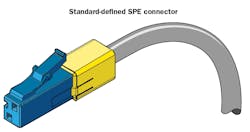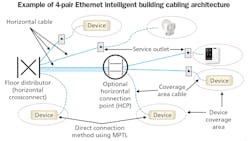By Adnan Ahmed, Mark Dearing, Todd Harpel, and Valerie Maguire, Single Pair Ethernet Consortium
For many years, Ethernet has been the most widely installed network technology for information transport. More recently, Ethernet has begun to support data exchange in systems that were previously the domain of a variety of other networking standards such as EIA/TIA-232 (RS-232) and TIA-485 (RS-485), CAN, HART, and other proprietary communication protocols. The desire to connect every type of device in every type of environment has led to the implementation of Ethernet as the universal transport system across industries and applications. As Ethernet transmission speeds increased, the IEEE recognized the need for additional options to support lower-speed transmission rates for specific applications and environments.
As a result, the most recent addition to the IEEE Std 802.3 standard is the IEEE Std 802.3cg-2019 amendment specifying 10-Mbit/sec transmission over single balanced twisted-pair copper cabling. While initially targeted at industrial and automotive environments, there are also opportunities for building automation functions. This article will examine the network architecture and use cases made possible by the application of this new technology in support of intelligent buildings and the Internet of Things (IoT).
Growing demand for SPE
It may surprise commercial building network managers, but standards for single-pair Ethernet (SPE) have been in place for many years. The first two published SPE standards (IEEE Std 802.3bw and IEEE Std 802.3bp), operating at 100 Mbits/sec and 1,000 Mbits/sec respectively, were specifically targeted for the automotive market. Automotive applications have a well-defined (and small) area to support, so the reach was limited to 15 meters (100Base-T1) or 15 and 40 meters (1000Base-T1).
However, IEEE 802.3 recognized the need to support single-pair Ethernet connections at much greater distances in industrial environments. To enable the longer cable runs required for industrial applications, the IEEE 802.3cg amendment provides for 10-Mbit/sec transmission at a reach of up to 1,000 meters (10Base-T1L), as well as supporting 15-meter link segment (10Base-T1S) for automotive and industrial cabinet environments. There is also an optional 25-meter “multidrop” configuration that allows for up to eight devices to be connected in a single “mixing segment.” The mixing segment implementation will be an engineered system and is not intended to be preinstalled as structured cabling.
These industrial environments operate using machine-to-machine (M2M) communication that typically occurs between low-complexity components commonly found in control and automation systems. The fieldbus devices in these systems include sensors that can detect light, heat, motion, moisture, pressure, or any other environmental phenomena and respond with information or an instruction. They also include actuators that can move or control a mechanism such as a valve, light, or an electrically controlled switch used for opening or closing a power circuit (e.g., a disconnect, relay, or contactor). These systems have been moving from older, proprietary communication protocols to Ethernet networks and the new SPE standard provides a seamless migration path to ensure interoperability between diverse systems and system vendors.
Similarly, many of the controls, sensors, systems, and devices used in an intelligent building—often referred to as the building’s operational technology (OT)—that operate over BACnet or other proprietary fieldbus communication systems may soon have the ability to be connected through the use of an SPE network. The Building Internet of Things (BIoT) provides a degree of automation, intelligence, and system integration that enables a variety of benefits for the buildings’ owners and occupants. Although this new single-pair network will be an Ethernet based system and could be connected to the building’s business local area network (LAN) if the 10Base-T1L signal is converted to 10/100/1000Base-T, the two systems are often under the purview of different system managers. It may be that the single-pair OT network will be operated and managed separately initially, but eventually the information technology (IT) and OT networks will need to converge in a similar manner to what occurred with voice and data networks. Convergence allows for the full benefits of the smart building systems to be realized.
TIA cable and connectivity standards for SPE
To support this new single-pair Ethernet network technology, the TIA TR-42 Telecommunications Cabling Systems Engineering Committee has undertaken the work to develop new SPE cable, connector, and channel performance specifications. The TR-42.7 Telecommunications Copper Cabling Systems Subcommittee is developing ANSI/TIA-568.5 for the purpose of defining the cable and channel transmission performance characteristics needed to support the 10Base-T1L application defined by IEEE 802.3cg. The TIA standard is in the early process of ballot review, with draft content subject to change, and currently defines two channel configurations. One variant (SP1-400) supports a maximum 400-meter reach with up to 5 connections. The number of connectors in the channels are aligned with the recommendations of the IEEE P802.3cg 10-Mbit/sec Single Pair Study Group, whose members recognized early on that long links consisting of large, heavy fieldbus cables are usually split into shorter segments and connected using field junction boxes.
Single-pair Ethernet cabling designs for the SP1-1000 and SP1-400 channels may be shielded or unshielded. Allowable cable conductor size ranges from 18 AWG to 26 AWG, depending on the application and the power class being deployed. TIA has created specifications for SP1-1000 cable and channels that will likely use 18-AWG conductors to achieve the maximum reach. SP1-400 cable and channel specifications will likely use 23-AWG conductors.
In addition to new cable designs for SPE, the ANSI/TIA-568.5 draft document introduces a new SPE connector type for use in commercial building environments. The connector, defined in IEC 63171-1, is commonly referred to as a “copper LC” because its form factor looks like the well-known optical fiber LC connector. Although not stated as a requirement, the outlet/connector subclause in TIA-568.5 says that the IEC 63171-1 connector should be used at the equipment outlet. This is aligned with the IEEE 802.3cg guidance, which also doesn’t preclude the use of screw-terminal or other connector interfaces at 10Base-T1L active equipment ports.
Just like 4-pair Ethernet cabling, SPE cabling will allow for the transmission of data and power over the same cable, but the standards are different. Power transmission over 4-pair Ethernet cabling is defined by IEEE Std 802.3bt, commonly called Power over Ethernet (PoE). Power transmission for single-pair Ethernet cabling is defined in IEEE Std 802.3bu, commonly referred to as Power over Data Lines or PoDL (a.k.a. “poodle”). The IEEE 802.3bu standard provides for multiple classes of powered devices delivering between 0.5 and 50 watts of power. Even though PoDL power delivery technology is not compatible with existing 2- and 4-pair PoE equipment, it shares the same advantages as PoE in that it provides for centralized power control and power backup.
TIA is also developing three documents that address SPE implementations and use cases for generic structured cabling. ANSI/TIA-568.0-E-1 is a proposed addendum to the recently published standard for generic cabling that will describe use cases, topology, and architectures related to single-pair cabling. It will include new terminology related to intelligent buildings, such as IoT and M2M, as well as specifications for SPE cable pull tension and bend radius, cable terminations, cords and jumpers, bonding, separation from power, and electrostatic discharge. The next revision of the ANSI/TIA-862 Intelligent Building Systems standard (ANSI/TIA-862-C) is expected to include SPE cabling recommendations. Work will soon begin on a new standard, which will likely be called ANSI/TIA-568.7, for single twisted-pair cabling for industrial applications. Additionally, the TIA Single Pair Ethernet Consortium (SPEC) advocates for the role that SPE technology will play in intelligent buildings
SPE cabling technology
Network topology for intelligent buildings using SPE cabling will have several options available that traditional 4-pair Ethernet networks do not. For example, single-pair networks will typically use a traditional star wired topology, but with the added flexibility to extend the links beyond 100 meters.
The network topology for intelligent buildings currently outlined for 4-pair cabling in ANSI/TIA-862-B and BICSI 007 encourages the use of a zone cabling architecture that employs horizontal connection points (HCPs) from which multiple links can be distributed to the equipment outlets (also called service outlets) in a coverage area. While not all aspects of this architecture are explicitly approved, this topology could be well suited to SPE cabling supporting many different building functions such as lighting control, HVAC control, occupancy sensors, and other familiar low-speed automation devices.
Promising future
Although 10Base-T1L active equipment is not yet available, Analog Devices Inc. recently announced the availability of a 10Base-T1L PHY—the underlying circuitry required to implement physical layer functions for a 10Base-T1L network—and showcased it in a demonstration connecting various industrial sensors over 1000 meters of single-pair cable. Industrial network designers know that an all-Ethernet infrastructure will provide more bandwidth and power than previously available through legacy fieldbus technology. It is anticipated that 10Base-T1L technology will quickly facilitate the use of Ethernet to the edge of the network to realize the ambition of Industry 4.0: smart manufacturing.
Even though initial IEEE single-pair Ethernet standards were primarily targeted at automotive and industrial environments, it has become clear that this technology promotes expansion of Ethernet into the OT and IoT device ecosystems that make our buildings smarter. The addition of SPE cabling as a recognized media for intelligent building networks and the identification of commercial building SPE use cases expected in the next revision of ANSI/TIA-862-B will drive SPE switch and device product launches. Bolstered by increased interest in smart building technology, deployment of this new technology is poised to burst onto the structured cabling scene once the standards are completed.
Adnan Ahmed, RCDD, DCDC, RTPM, WD is director of the technical advisory and solutions group at R&M. Mark Dearing, RCDD, DCDC is senior manager for engineering, standards, regulatory and document control with Leviton. Todd Harpel, RCDD is director of standardization with Berk-Tek LLC. Valerie Maguire, BSEE is distinguished engineer with The Siemon Company. Berk-Tek, Leviton, R&M and Siemon are members of the TIA’s Single Pair Ethernet Consortium.

